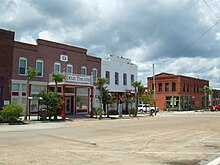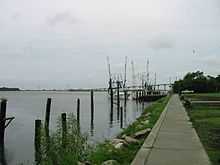Apalachicola, Florida
Apalachicola, Florida | |
|---|---|
 A street in Apalachicola showing the Dixie Theatre | |
 Location in Franklin County and the state of Florida | |
| Country | |
| State | |
| County | Franklin |
| Area | |
| • Total | 2.7 sq mi (6.9 km2) |
| • Land | 1.9 sq mi (4.9 km2) |
| • Water | 0.8 sq mi (2 km2) |
| Elevation | 13 ft (4 m) |
| Population (2000) | |
| • Total | 2,334 |
| • Density | 864.4/sq mi (338.3/km2) |
| Time zone | UTC-5 (Eastern (EST)) |
| • Summer (DST) | UTC-4 (EDT) |
| ZIP codes | 32320, 32329 |
| Area code | 850 |
| FIPS code | 12-01625Template:GR |
| GNIS feature ID | 0277920Template:GR |


Apalachicola is a city in Franklin County, Florida, on US 98 about 80 miles (130 km) southwest of Tallahassee. The population was 2,334 at the 2000 census. The 2005 census estimated the city's population at 2,340.[1] Apalachicola is the county seat of Franklin County.Template:GR
Name
"Apalachicola" comes from the Apalachicola tribe and is a combination of Hitchiti Indian words "apalahchi", meaning "on the other side", and "okli", meaning "people". In original reference to the settlement, it probably meant "people on the other side of the river".[2][3] Many inhabitants of Apalachicola, however, choose to translate the name of their town as "land of the friendly people".[4]
Geography and climate
Apalachicola is located in the northwest part of the state, at 29°43′31″N 84°59′33″W / 29.725203°N 84.992534°W,Template:GR on Apalachicola Bay and at the mouth of the Apalachicola River.
According to the United States Census Bureau, the city has a total area of 2.7 square miles (7.0 km2), of which 1.9 square miles (4.9 km2) is land and 0.8 square miles (2.1 km2) of it (29.32%) is water.
| Monthly Normal and Record High and Low Temperatures | ||||||||||||
| Month | Jan | Feb | Mar | Apr | May | Jun | Jul | Aug | Sep | Oct | Nov | Dec |
|---|---|---|---|---|---|---|---|---|---|---|---|---|
| Rec High °F | 79 | 80 | 85 | 90 | 98 | 101 | 102 | 99 | 96 | 93 | 87 | 82 |
| Norm High °F | 62.4 | 64.8 | 69.9 | 76 | 83 | 88.3 | 89.8 | 89.4 | 87 | 79.9 | 72 | 65 |
| Norm Low °F | 43 | 45.8 | 51.4 | 57.6 | 65.1 | 71.6 | 73.9 | 74 | 71.2 | 60.5 | 52 | 45.3 |
| Rec Low °F | 9 | 21 | 22 | 36 | 47 | 48 | 63 | 62 | 50 | 37 | 24 | 13 |
| Precip (in) | 4.87 | 3.76 | 4.95 | 3 | 2.62 | 4.3 | 7.31 | 7.29 | 7.1 | 4.18 | 3.62 | 3.51 |
| Source: USTravelWeather.com[5] | ||||||||||||
History
A trading post called Cottonton was located on the current site of Apalachicola. In 1827, the town was incorporated as West Point. Apalachicola received its current name in 1831, by an Act of the Legislative Council of the Territory of Florida.
Before the development of railways in the Gulf states, Apalachicola was the third busiest port in the Gulf of Mexico (behind New Orleans and Mobile). In the late 19th century and early 20th century, the sponge trade, led by Greek immigrants, was a major industry in the town. Apalachicola is still the home port for a variety of seafood workers, including oyster harvesters and shrimpers. More than 90% of Florida's oyster production is harvested from Apalachicola Bay. Every year the town hosts the Florida Seafood Festival. The bay is well protected by St. Vincent Island, Flag, Sand, St. George Island, and Cape St. George Island.

Trinity Episcopal Church was incorporated by an Act of the Legislative Council of the Territory of Florida on Feb 11, 1837. The building was one of the earliest prefabricated buildings in America. The framework was shipped by schooner from New York and assembled in Apalachicola with wooden pegs.
Botanist Alvan Wentworth Chapman (1809–1899) settled in Apalachicola in 1847.[citation needed] In 1860, he published his major work, Flora of the Southern United States. The former (now closed) elementary school is named in his honor.
In 1849, Apalachicola physician Dr. John Gorrie (1802–1855) discovered the cold-air process of refrigeration and patented an ice machine in 1850, as the result of experiments to lower the temperatures of fever patients, laying the groundwork for modern refrigeration and air-conditioning. The city has a monument to him, and a replica of his ice machine is on display in the John Gorrie Museum.
On April 3, 1862, the gunboat USS Sagamore and 186-foot (57 m) steamer USS Mercedita (relieving the USS Marion) captured Apalachicola.[6]
In 1979, Exxon relocated their experimental subsea production system from offshore Louisiana to a permitted artificial reef site off Apalachicola, Florida making this the first effort to turn an oil platform into an artificial reef.[7]
Apalachicola is also home to the Dixie Theater,[8] a professional Equity theater which is both a producing as well as presenting performance venue. It is considered the artistic center of Franklin County. Originally built in 1912, it was fully renovated beginning in 1996 and reopened in 1998.
The AN Railway, formerly the Apalachicola Northern Railroad, serves the city.

Demographics
As of the censusTemplate:GR of 2000, there were 2,334 people, 1,006 households, and 608 families residing in the city. The population density was 1,242.1 inhabitants per square mile (479.3/km²). There were 1,207 housing units at an average density of 642.3 per square mile (247.9/km²). The racial makeup of the city was 63.41% White, 34.92% African American, 0.17% Native American, 0.39% Asian, 0.47% from other races, and 0.64% from two or more races. Hispanic or Latino of any race were 1.67% of the population.
There were 1,006 households out of which 23.4% had children under the age of 18 living with them, 41.8% were married couples living together, 15.0% had a female householder with no husband present, and 39.5% were non-families. Of all households, 34.7% were made up of individuals and 14.8% had someone living alone who was 65 years of age or older. The average household size was 2.24 and the average family size was 2.87.
In the city the population was spread out with 21.9% under the age of 18, 7.0% from 18 to 24, 24.0% from 25 to 44, 26.7% from 45 to 64, and 20.5% who were 65 years of age or older. The median age was 43 years. For every 100 females there were 90.2 males. For every 100 females age 18 and over, there were 86.3 males.
The median income for a household in the city was $23,073, and the median income for a family was $28,464. Males had a median income of $22,500 versus $18,750 for females. The per capita income for the city was $12,227. About 19.9% of families and 25.3% of the population were below the poverty line, including 32.4% of those under age 18 and 15.0% of those age 65 or over.
Travel
Travel to Apalachicola continues to increase as tourists seek experiences of "Old Florida", as many describe the feel of smaller coastal communities in the state. Southern Living published a feature article "Florida's Quiet Side" in February 2007. Wanda McKinney writes:
Morning comes gently to Apalachicola. Oyster boats and shrimpboats begin their daily pilgrimages into the seafood-rich bay as the sun rises on the Northwest Florida coast. The lights twinkle on in this fishing village, its residents ready for another day in unspoiled paradise. If you ever wondered if such a place still exists, yes, old Florida lives here. A lone blinking yellow light directs the downtown traffic. Come and stay awhile in this wonderful, walkable, watery hamlet. Try the pace on for size.[9]
Education
Apalachicola is a part of the Franklin County Schools system.[10] As of the 2008–2009 school year, all students, except those attending charter schools, attend the K–12 Franklin County School. Apalachicola Bay Charter School is also located in Apalachicola.
Apalachicola in Popular Culture
- Apalachicola is mentioned in the 2009 Tim McGraw song "Southern Voice".
- In the 1947 Bob Hope, Bing Crosby film Road to Rio, Hope sings ("We're on Our Way to...) Apalachicola, F-L-A" which was written by Crosby.
- Apalachicola is mentioned in the 2006 Tom T. Hall song "Redneck Riviera".
References
- This article incorporates text from a publication now in the public domain: Chisholm, Hugh, ed. (1911). Encyclopædia Britannica (11th ed.). Cambridge University Press.
{{cite encyclopedia}}: Missing or empty|title=(help)
- ^ Estimated 2005 U.S. Census for Apalachicola
- ^ Florida Heritage Facts
- ^ Florida Department of State
- ^ Bay Navigator, Brief History
- ^ http://www.ustravelweather.com/weather-florida/apalachicola-weather.asp
- ^ USS Mercedita history
- ^ Dauterive, Les (2000). "Rigs-To-Reefs policy, progress, and perspective". In: Hallock and French (eds). Diving for Science...2000. Proceedings of the 20th Annual Scientific Diving Symposium. American Academy of Underwater Sciences. Retrieved 2011-01-07.
- ^ [1]
- ^ "Florida's Quiet Side"
- ^ Franklin County Schools website
External links
- Apalachicola City Website
- Apalachicola Chamber of Commerce
- Commercial Advertiser newspaper that serves Apalachicola, Florida is available in full-text with images in Florida Digital Newspaper Library
- Dixie Theatre
- Apalachicola River Watershed - Florida DEP
- Historic Apalachicola

